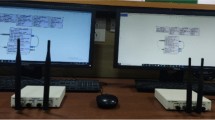Abstract
In this paper, we propose a mathematical model of aggregate co-channel interference over Rayleigh fading in cognitive networks. Unlike the statistical models in the literature that aim at finding the bound or approximation of the interference, the proposed model gives an accurate expression of probability density function (PDF), cumulative distribution function (CDF) and mean and variance of the interference, which takes into account a number of factors, such as spectrum sensing scheme, and spatial distribution of the secondary users (SUs). In particular, we focus on a more general spatial structure where there are two roles of primary users (PUs) and the interfering SUs distributed in the two-dimensional space. The framework developed in this paper is easy to be applied in power control, error evaluation and other applications.
Similar content being viewed by others
References
Ghasemi A, Sousa E S. Interference aggregation in spectrum-sensing cognitive wireless networks [J]. IEEE Journal of Selected Topics in Signal Processing, 2008, 2(1): 41–56.
Rabbachin A, Quek T Q S, Shin H, et al. Cognitive network interference [J]. IEEE Journal on Selected Areas in Communications, 2011, 29(2): 480–493.
Chen Z M, Wang C X, Hong X M, et al. Aggregate interference modeling in cognitive radio networks with power and contention control [J]. IEEE Transaction on Communications, 2012, 60(2): 456–468.
Haenggi M, Ganti R K. Interference in large wireless networks [J]. Foundations and Trends in Networking, 2008, 3(2): 127–248.
Win M Z, Pinto P C, Shepp L A. A mathematical theory of network interference and its applications [J]. Proceedings of the IEEE, 2009, 97(2): 205–230.
Dahama R, Sowerby K W, Rowe G B. Outage probability estimation for licensed systems in the presence of cognitive radio interference [C]//in Proceedings of the IEEE 69th Vehicular Technology Conference (VETECS’ 09). Barcelona: IEEE, 2009: 1–5.
Salbaroli E, Zanella A. Interference analysis in a Poisson field of nodes of finite area [J]. IEEE Transaction on Vehicular Technology, 2009, 58(4): 1176–1783.
Vijayandran L, Dharmawansa P, Ekman T, et al. Analysis of aggregate interference and primary system performance in finite area cognitive radio networks [J]. IEEE Transaction on Communications, 2012, 60(7): 1811–1822.
Kusaladharma S, Tellambura C. Aggregate interference analysis for underlay cognitive radio networks [J]. IEEE Wireless Communications Letters, 2012, 1(6): 641–644.
Pinto P C, Win M Z. Communication in a Poisson field of interferers. Part I. Interference distribution and error probability [J]. IEEE Transaction on Wireless Communications, 2010, 9(7): 2176–2186.
Lee C H, Haenggi M. Interference and outage in Poisson cognitive networks [J]. IEEE Transaction on Wireless Communications, 2012, 11(4): 1392–1401.
Stüber G L. Principles of mobile communication [M]. New York: KLUWER, 2002: 39–152.
Li J, Li S H. Interference of cognitive wireless networks on Rayleigh and rice fading channels [J]. International Journal of Distributed Sensor Networks, 2014. DOI: 10.1155/2014/236891 (published online).
Kingman J F C. Poisson processes [M]. New York: Oxford University Press, 1993.
Moghimi F, Nasri A, Schober R. Adaptive Lpnorm spectrum sensing for cognitive radio networks [J]. IEEE Transaction on Communications, 2011, 59(7): 1934–1945.
Wen Y B, Loyka S, Yongacoglu A. Asymptotic analysis of interference in cognitive radio networks [J]. IEEE Journal on Selected Areas in Communications, 2012, 30(10): 2040–2052.
Author information
Authors and Affiliations
Corresponding author
Additional information
Foundation item: the National Natural Science Foundation of China (Nos. 61071152 and 61271316), the National Basic Research Program (973) of China (Nos. 2010CB731406 and 2013CB329605) and the National “Twelfth Five-Year” Plan for Science & Technology Support (No. 2012BAH38B04)
Rights and permissions
About this article
Cite this article
Li, J., Li, Sh. A novel interference modeling scheme in cognitive networks. J. Shanghai Jiaotong Univ. (Sci.) 20, 540–547 (2015). https://doi.org/10.1007/s12204-015-1661-4
Received:
Published:
Issue Date:
DOI: https://doi.org/10.1007/s12204-015-1661-4




